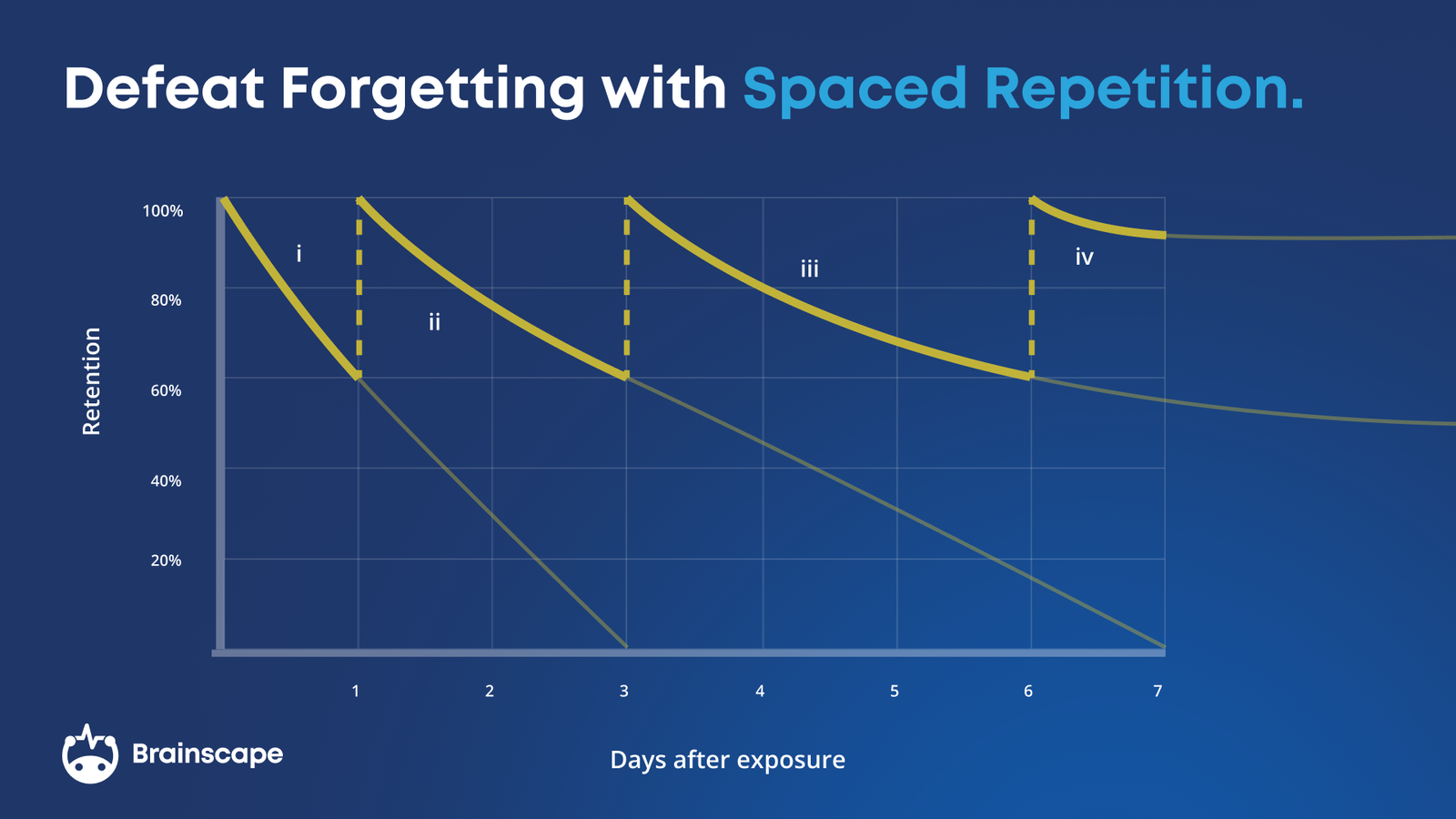Based on decades of research, the best way to learn a language is by using the language—reading, listening, and speaking. This is great news for independent and self-motivated learners like you, as it is easier than ever to find online resources to help you take control of your language learning.
But whether you're using Brainscape's language flashcards or not, we still want to make sure you have a comprehensive set of resources to really build your language-learning journey according to the way you learn. So, in this guide, we cover 10 tools you need to learn a language online.
Ready? Let’s dive in!
Must-Have Language Tool # 1: Real-World Motivation
Motivation is essential when learning a language online because it is a long and hard journey. It can take years to become fluent. No language-learning effort will ever “stick” unless you're deeply motivated.
How do you find this motivation? You MUST have a real-life goal that is important enough to you to keep you motivated:
- Understanding your Colombian husband's family.
- Traveling or moving to a foreign country.
- Attending an international conference (or work).
- Wanting to smash out an "A" in French class.
Whatever it is, remember that your motivation will have to sustain you through those periods when you'd rather relax on the couch than practice verb conjugations. You’ve gotta want it. Otherwise, maybe you shouldn't learn a language after all (and that's okay).
Techniques to Cultivate Motivation
- Develop a clear vision and goals. Part of staying motivated is to clearly see what you’re working towards. Without a clear vision of where you’re going, it’ll be hard to stay motivated to get there. As a first step, pick a goal.
- Make language study a daily habit. Develop the habit of studying every day or attaching your studying to another activity that you do regularly, such as making dinner or going for a run, so that it doesn't feel like "work".
- Study a little at a time. Flashcard apps like Anki or Brainscape make this easy by allowing you to study in short rounds of 10 cards each, which are easy to squeeze into short breaks in your day. Also, its engineered to help you learn the way your brain was built to learn so you'll find yourself absorbing (and remembering) vocabulary so much quicker.
- Keep track of your progress. One of the best ways to stay motivated to learn a language is to see how far you’ve come. Take tests regularly or, better yet, practice with a foreign-language partner to feel your proficiency improve.
At the end of the day, regular work over a long period must be done. There are no shortcuts!
Tool # 2: A Vocabulary & Grammar App
Languages are ENORMOUS bodies of information to learn. To break down all this content, we strongly recommend an adaptive flashcard app for vocab and grammar practice. Flashcards facilitate the important mental activities of active recall and spaced repetition to improve your learning speed, and they can be a convenient tool for when you have just a few minutes to knock out some practice on your smartphone.
Flashcard apps such as RemNote or Brainscape leverage proven cognitive science to help you learn as fast and as painlessly as humanly possible. They use spaced repetition systems (SRS) that repeat each flashcard at the best possible time. You'll see information just before you forget it, maximizing its memory imprint.

Bonus: You can learn anywhere, at any time. In line for coffee? Waiting for a colleague? Microwaving your lunch? You can smash out vocabulary flashcards on digital apps wherever you can use a phone.
Tool # 3: A Digital Dictionary
As you engage in conversation and watch media in your new foreign language, you’ll naturally run into words and phrases that you don’t recognize. You'll need the right dictionary where you can find any form of a word and not just the root or infinitive form.
- Linguee. Linguee is both a dictionary and a phrase translator tool. It lets you see tons of examples of each phrase being used in context, helping you to internalize the true versatility of the language.
- Google Translate. Google Translate is one of the biggest translators on the net and benefits from thousands of people contributing to verify translations.
- Word Reference. Word Reference combines a dictionary tool with online forums and a verb conjugator tool.
- Context Reverso. Context Reverso uses a repository of texts paired with their translations to identify translations organically in real-life texts with context-rich examples.
Tool # 4: An App for Recording (& Practicing) New Words & Phrases
Now that you’ve looked up your new word, you need a way to record it. Smart language learners are diligent about keeping a notebook or note-taking app on them at all times and are constantly logging their newly acquired phrases so that they can review them again later.
Tool # 5: A Conversation Partner(s)
The best way to learn a language is to use it. That means you should be speaking the foreign language the whole time you are learning—even if (especially if) you struggle. A conversation partner is critical to maintaining that mental progress checkpoint and correcting you on your phonetics. Plus, it increases your motivation to study!
People accomplish more when they feel like they’re working in a team. You’re accountable for trying, you feel supported, and you get instantaneous feedback. If you can't find a native speaker, even just another fellow language learner could be useful to practice with. You simply need an excuse to actually speak the language.
Language Partner Options
- Language exchange sites. There are now a ton of language exchange websites and they're some of the best ways to learn a language online. Some options include My Language Exchange, Tandem, Conversation Exchange, Speaky, HiNative, and Polyglot Club. You can also find people on Craigslist and Reddit.
- Find a tutor. If you’re interested in getting a proper tutor, there are tons of online options for that as well such as Verbling, Superprof, Cambly, Italki, and Preply.
- Conversation clubs. You can also find meet-ups and conversation clubs in your area through websites like Meetup or by searching for language cafes. You’ll be surprised how many other people are as motivated as you to master new languages.
Don't be afraid to make mistakes! Conversation is about trying things out.
Tool # 6: Ear-eye Training Activities

Another essential tool for learning a language is any activity that trains your ears and eyes to sync up. We need to understand how a word sounds while it is still foreign to us. This is incredibly effective for learning a language.
Listening and reading your target language at the same time will improve your capability to do listening activities and reading activities by themselves. Yet this can’t just be any type of listening or viewing activity. It has to be appropriate for your skill level and interests. Watching a complicated movie as a beginner would otherwise just result in a string of gibberish flowing in one ear and out the other.
These activities are particularly helpful when it is a movie or book that you already know well so that you can figure out certain phrases’ meanings by their familiar context. At first, it doesn't even matter if you know what these words mean. You can’t fully learn to comprehend a stream of conversation if you haven’t yet been trained to hear when one word ends and the next begins.
Here are some options for doing that:
- Digital flashcards. Apps like Mochi or Brainscape's French and Spanish curricula pair an audio file with text, allowing you to read a sentence and hear it pronounced at the same time. This is especially useful for beginners.
- Read with a native person. If you have access to a native person, this is our favorite. For example, if your partner is Chilean, try reading a book together in Spanish. You can follow along with the words while they pronounce them.
- Audiobooks. If you don't have a friend or family member that can read along with you, the next best option is to read a physical book copy along with the audiobook version.
- Watch films with subtitles. For example, watch a documentary in French about a familiar topic and make sure that the closed-captioning turned on (also in French). Sometimes subtitles don’t match films exactly, but we find that documentaries tend to have text that matches the audio very closely.
- Listen to songs with their lyrics. You can find these anywhere you find music, from apps like Spotify to websites like Lyrics Playground and Genius.
- Podcasts. Some podcasts come with transcripts, especially those that are aimed at teaching people foreign languages. For example, both the Inner French podcast and the Leonardo English podcast have transcripts that you can follow along with. Look for others in your target language.
Tool # 7: Reading Activities
Aside from conversation with native speakers, reading is the best way to expose yourself to the large stream of words that are required to truly internalize your fluency—especially if you remember to look up all the new unfamiliar phrases in your dictionary app, and then make cards for those phrases in your flashcard app.
Once you’ve learned some basic vocabulary and grammar rules, you’ll be ready to start incorporating real-world reading activities into your learning rotation.
Reading Activity Options
- Change your phone’s language. You can change the language of your phone to be in another language. Or, change the interface language of just one social media app for starters.
- News. The news is a great way to get exposed to a new language while staying up-to-date on current events. Check out MIT library’s repository of non-English language newspapers.
- Articles. There are a ton of places to find great articles online. One of our favorites is Medium.com. Just search for non-English terms like “Ciencias” for science articles in Spanish.
- Books and magazines. Get ebooks in your target language easily at the Kobo store or Amazon. Other sources include Project Gutenberg, eBooks, iTunes, Google Play or even your local library. Or perhaps you subscribe to a local version of your favorite popular magazine, like Men's Health en Español.
Tool # 8: Listening Activities
Pure listening is more difficult than ear-eye training since we are now talking about listening without necessarily having the printed text to follow along with.
Some people confuse listening with hearing. While passively hearing is great for exposure, your listening exercises should encourage you to get actively involved. This means staying alert to new words and phrases, deciphering sounds and pronunciations, and actively checking your understanding.
Listening Activity Options
- Podcasts and Radio. You can listen anywhere, and, if it’s too difficult, you can always slow down the audio so it’s easier to understand. Find podcasts and radio shows from all over the world in a variety of languages on TuneIn.
- Documentaries. These tend to be spoken more slowly and clearly, without much slang. Many documentaries may even have closed captioning that is an exact verbatim match to the words being spoken aloud. You can find these on YouTube. For example, try the “Documentaire en Français” channel if you’re learning French.
- News. Listening to the news in other languages is another great option for clear, slow language. And it’ll keep you up-to-date with current affairs.
- Animated movies (e.g. Disney/Pixar). These are dubbed for children in multiple dialects and therefore tend to be standard and easy to understand (though not as easy as documentaries.
- Dubbed popular movies or shows. As with animated films, these dubbings are typically recorded by professional voice actors whose clarity transcends dialects and is spoken into a nice clear studio mic, rather than a lapel mic while they're in action. I'll never forget my evening watching L'Arme Fatale (Lethal Weapon) from my hotel room in Martinique and laughing at the disconnect between Mel Gibson's lips and the French words I heard. But it was great fun practice!
Here’s how to change your language on Netflix to get your favorite shows dubbed in your target language.
- Songs. Songs can be one of the best ways to train your ears in a foreign language because they are fun, repetitive, and can easily be looked up online to sing along to the lyrics. An extra bonus is that they can become a great topic of conversation with your new native-speaking friends. They'll be so impressed when you can sing along!
How can you find new music in a new language? Start finding what’s popular in other countries using the charts on any music streaming app. Then find a couple of artists you like and search for similar artists.
Just remember to make the most of the songs for learning by looking up the lyrics, finding new words that you learn in your dictionary, and making new flashcards for your new words.
Tool # 9: Writing Activities
If you’re not trying to go into academia or get a white-collar job using your new language, you may choose not to place too much focus on writing exercises. Still, these can really help you get a good sense of grammar. And since lots of our daily communication is still in writing (with text messages and emails), it’s good to get comfortable composing written texts in your target language.
With that in mind, here are some easy writing activity options.
Writing Activity Options
- Write letters or postcards. Practice your writing by finding a good ol’ fashioned pen pal. Try InterPals or another online penpal provider. And, of course, if snail mail isn’t really your pace, feel free to make it an email exchange.
- Keep a journal. A journal is one of the easiest ways to make writing in another language a part of your daily routine. Talk about what happened to you that day, how you’re feeling, or your dreams for the future. Try to use the new words you’ve learned recently in your daily entry.
- Join WhatsApp groups. There are tons of WhatsApp groups for language learners. You can search the internet to find one in your language.
In Go Forth & Learn Your Language

Learning a new language has incredible benefits, from being able to integrate into a new culture to making your brain grow. You have tons of motivations you pick from to learn a new language.
We’ve given you the tools you need to build your language program and be successful. Tools and methods are great but it’s your drive that will get you there in the end.
So it's up to you. (It’s worth it: the rewards of your diligence will last a lifetime.)
Additional Reading
- How brain science can help you learn a language faster
- Can you learn two languages at once? (Maybe, and here's how)
- Can you learn a foreign language by watching TV?
Sources
Allport, F. H. (1920). The influence of the group upon association and thought. Journal of Experimental Psychology, 3(3), 159.
Brown, R., Waring, R., & Donkaewbua, S. (2008). Incidental vocabulary acquisition from reading, reading-while-listening, and listening to stories. Reading in a Foreign Language, 20(2), 136-163.
Chang, A. C., & Millett, S. (2014). The effect of extensive listening on developing L2 listening fluency: Some hard evidence. ELT journal, 68(1), 31-40.
Chang, A. C. (2011). The effect of reading while listening to audiobooks: Listening fluency and vocabulary gain. Asian Journal of English Language Teaching, 21, 43-64.
Hamada, Y. (2018). Shadowing for pronunciation development: Haptic-shadowing and IPA-shadowing. Journal of Asia TEFL, 15(1), 167-183.
Kadota, S. (2019). Shadowing as a practice in second language acquisition: Connecting inputs and outputs. Routledge.
